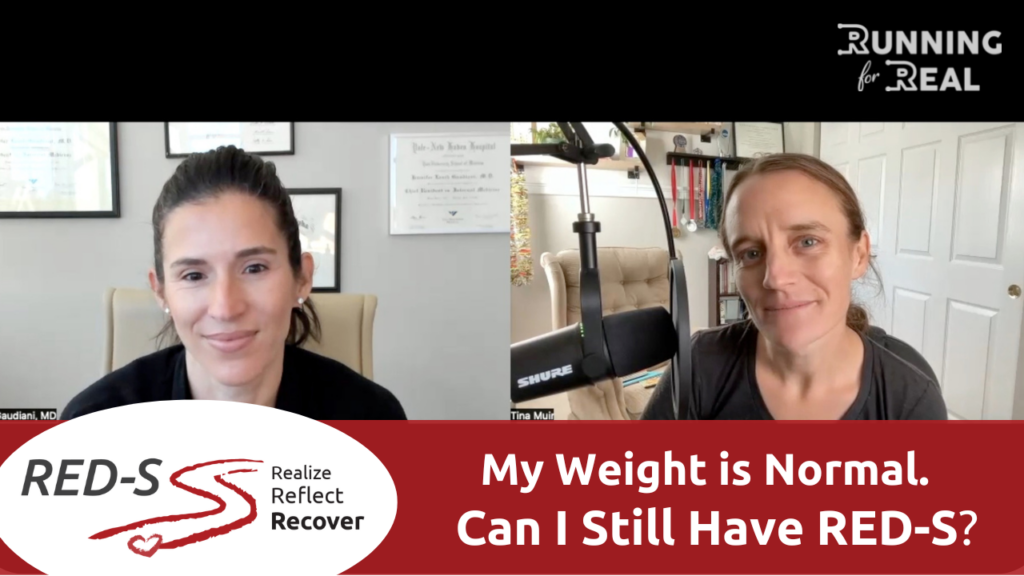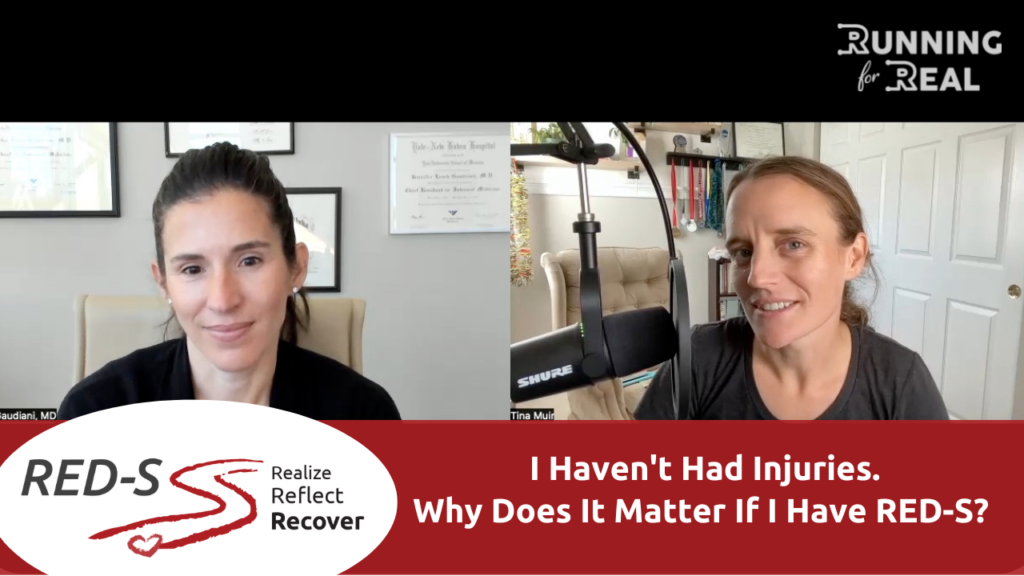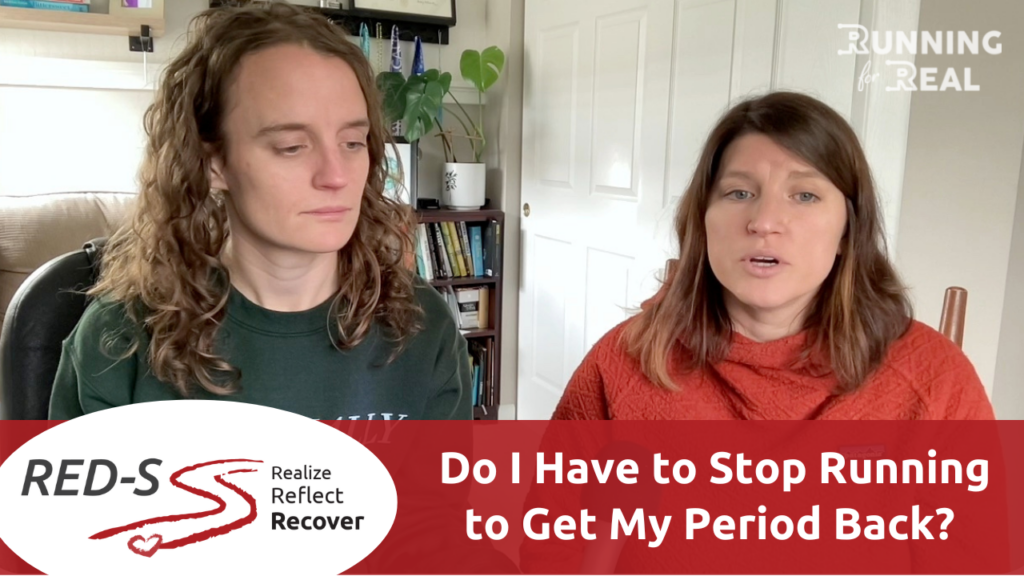Did you know that if you’ve lost your period you’re probably also losing bone density? That’s what contributes to stress fractures and eventually can cause osteopenia and osteoporosis.
Amenorrhea is the most obvious symptom of RED-S / REDs, but Relative Energy Deficiency in Sport also affects bone, thyroid, and hormone health. Performance expert Rebecca McConville explains how humans evolved to respond to a deficit in their energy supply.
Read the transcript
[Tina] What is RED-S? What does that even mean? And how is that different to amenorrhea?
[Becca] So what is RED-S, or sometimes I call it “Reds” and I don’t know if that’s correct or not, is Relative Energy Deficiency in Sport. However, I like to actually kind of sometimes view it from a deficit. When we think about things in terms of money, which we all can relate to, there is a mismatch between your energy currency coming in – your caloric intake – versus your energy currency going out, which is your energy expenditure.
Your body does have three savings accounts that it can use energy for if it has to. So we have our liver, which is what supplies energy to our brain; that’s what allows our brain to stay focused. And contrary to what most people don’t realize, it needs about 20 percent or more of our daily energy needs, hence why we get a little brain foggy when we don’t have enough, or [laughs] I get kind of irritable.
Our muscle can serve as an energy source and body fat. But those are our emergency reserves. Our body doesn’t like to have to give up its emergency reserves. So once the body has been kind of chiseling away using that, it’ll actually kind of set a break and not allow it to use any more. Think about it; body fat has been our survival primal energy source to overcome famines, and as an athlete, we sure wouldn’t want to be giving up our muscle for energy source because that’s our power and our explosion and our endurance capacity.
So then the brain and the body switch, and now they start conserving energy inside of the body. And so it’ll start dimming functions to things like our body temperature, bone. It views growth or recycling bone density as a luxury, if we can’t even pay our day-to-day energy needs.
Sexual health and reproduction would then be something that the body’s like, “Hey, if we’re not safe enough to to get enough energy in, then reproduction should not be happening at this time. Let’s shut off energy here.” If you think about a business that’s going through and trying to conserve budget, it’s going to think about what’s necessary versus unnecessary.
Amenorrhea can happen secondary to other causes than RED-S. Can be stress, it can also be things that cause hormonal dysfunction like polycystic ovary syndrome. There are some other pituitary gland conditions as well, that can disrupt menstrual cycle. Obviously, pregnancy is one thing that can sometimes obviously lead to to a cessation of cycle. It doesn’t have to be low energy availability, but that’s what’s important at looking at the whole person, as well.
[Tina] And when I said about it being different to amenorrhea, is it… you said that that can be caused by various things, it’s not just about caloric deficit. Is that typically something, those two do typically go hand- in-hand, if someone has lost their period it is likely due to energy deficit?
[Becca] That’s usually the number one primary cause of it is low energy availability, and you’ll see it doesn’t always start out first with the loss of cycle; sometimes there’s a shorter duration or the bleed is lighter, as well. Then we end up seeing the consecutive loss of cycle.
[Tina] Okay, thank you. And to answer the age-old argument, are we literally talking about calories in versus calories out here for the deficit? Is RED-S as simple as that, if you’re not eating enough, you’re gonna start having symptoms of RED-S, or is there more to it?
[Becca] Ah, that’s what sounds like a simplistic question in the beginning. Yes, but then what the body will do is conserve your resting metabolic rate. So you’ll actually see now there’s some studies that are looking at that, where somebody’s resting metabolic rate will drop as a way to conserve energy since there’s not enough calories coming in.
So then what that does, is reduce the amount of calories going out, but that’s at a consequence of bone health; loss of cycle; your energy level being low; thyroid function starts to drop, which means we get a lower body temperature; we might even have hair, skin, and nail changes. So sorry, I didn’t give a very direct answer because it’s a hard question to answer.
[Tina] Okay, thank you. No, that’s I think, what we needed to hear.
check it out
Recovering from RED-S is hard. It’s even harder if you’re working through it alone. Even if you have professional support, they’re not available 24-7, and that can lead to going down search engine rabbit holes that have the potential to derail everything.
Our online resource, RED-S: Realize. Reflect. Recover, will answer all those questions swimming around in your head about recovery. It will give you the opportunity to connect with the experts you’ve come to know here, and to surround yourself with a community of others who are going through it too. THANK YOU! to Athletic Greens and Tracksmith for supporting this YouTube series and RED-S: Realize. Reflect. Recover.
Go to athleticgreens.com/reds to get five free travel packs of AG1 and a free one year’s supply of vitamin D3+K2 with your subscription!
When you go to https://tracksmith.com/tina and use the code TINA15 at checkout, you’ll get free shipping and Tracksmith will donate 5% of your order to Rising Hearts, the Indigenous-led nonprofit founded by Jordan Marie Daniels.
more about becca:
Rebecca McConville, RD, LD, CSSD, CEDS, is a sports nutrition and performance expert who helps her clients explore and strengthen their relationship with food, weight, body image and sports performance. Her book, “Finding Your Sweet Spot,” helps athletes maximize their potential while avoiding the dangers of RED-S. You can find Becca at https://beccamcconville.com.
more you might like…




